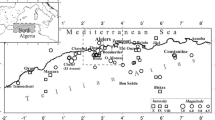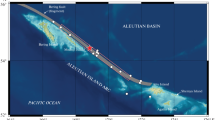Abstract
The Mw 7.6 Olyutorskii earthquake of April 20, 2006, struck the southern edge of the Koryak Highland, in a region of great complexity at the junction of the North American, Eurasian, and Pacific plates. This seismic event was notable for several remarkable features. Firstly, it had an unexpectedly large magnitude, leading to a reassessment of the seismic hazard in the Northern Kamchatka region. Secondly, the GCMT focal mechanism solution showed two nodal planes corresponding to nearly thrusting displacements on a 40–51° dipping rupture plane. However, geological field studies conducted in the epicentral area allow to map at the surface three primary segments of a 120 km long rupture zone. The central segment showed predominant right-lateral strike-slip displacements, while the NE and SW segments exhibited mostly thrusts steeply dipping SE with smaller strike-slip components. Thirdly, aftershocks were recorded in an area extending over 200 km southwestward from the surface ruptures mapped in the field, with an intense activity observed in a vast area 75 km to the NW from the surface ruptures. Fourthly, although the ruptures found during fieldwork were dipping to the SE, most aftershocks occurred NW of them, with their depth decreasing in the NW direction. SAR interferometry resolved this apparent discrepancy between seismological and field-geology data, indicating that the primary displacements occurred northwest from the central and southwest segments of the ruptures at the earth's surface. We present in our study a new rupture model based on SAR, GPS, and field geology data. The model consists of a major blind thrust extending NW and three rear subvertical ruptures that reached the earth's surface and were mapped during the field survey. Additionally, models of the main Mw 6.6 aftershocks that occurred on April 29, 2006, and May 22, 2006, are presented. Our new model reconciles all collected data, with a direction of movements on the major thrust agreeing with the rotation of the previously suggested Beringia microplate around a pole situated in the North of the Chukotka peninsula.





Similar content being viewed by others
Notes
References
Abubakirov, I. R., Gusev, A. A., Guseva, E. M., Pavlov, V. M., & Skorkina, A. A. (2018). Mass determination of moment magnitudes Mw and establishing the relationship between Mw and ML for moderate and small Kamchatka earthquakes. Izvestiya, Physics of the Solid Earth, 54, 33–47. https://doi.org/10.1134/S1069351318010019
Argus, D. F., Gordon, R. G., & DeMets, C. (2011). Geologically current motion of 56 plates relative to the no-net-rotation reference frame. Geochemistry, Geophysics, Geosystems, 12, Q11001. https://doi.org/10.1029/2011GC003751
Cook, D. B., Fujita, K., & McMullen, C. A. (1986). Present-day interactions in northeast Asia: North American, Eurasian, and Okhotsk plates. Journal of Geodynamics, 6, 33–51. https://doi.org/10.1016/0264-3707(86)90031-1
DeMets, C., Gordon, R. G., Argus, D. F., & Stein, S. (1994). Effect of recent revisions to the geomagnetic reversal time scale on estimates of current plate motions. Geophysical Research Letters, 21, 2191–2194. https://doi.org/10.1029/94GL02118
Diament, M., Mikhailov, V., & Timoshkina, E. (2020). Joint inversion of GPS and high-resolution GRACE gravity data for the 2012 Wharton basin earthquakes. Journal of Geodynamics, 136, 101722. https://doi.org/10.1016/j.jog.2020.101722
Fedotov, S. A. (1972). The Energy Classification of Earthquakes and the Magnitude Problem. Nauka. (In Russian).
Fedotov, S. A., Chekhovich, V. D., & Egorkin, A. V. (2011). Deep neogene structure and modern seismicity of the southern part of the Koryak Highland. Doklady Earth Sciences, 437, 455–459. https://doi.org/10.1134/S1028334X1104012X
Gordeev, E. I., Gusev, A. A., Levin, V. E., Bakhtiarov, V. F., Pavlov, V. M., Chebrov, V. N., & Kasahara, M. (2001). Preliminary analysis of deformation at the Eurasia—Pacific—North America plate junction from GPS data. Geophysical Journal International, 147(1), 189–198. https://doi.org/10.1046/j.0956-540x.2001.01515.x
Lander, A.V., Pinegina, T.K. (2010). Paradoxes of the focal zone of the 2006 Olyutorskii earthquake: Deep structure and dynamics. In: Proceedings of the Second Regional Scientific and Technical Conference "Problems of Integrated Geophysical Monitoring of the Russian Far East". V.N. Chebrov (Ed.). Petropavlovsk-Kamchatsky, UGS RAS. 131–136. (http://www.emsd.iks.ru/konf091011/lib.php). (In Russian).
Lander, A. V., Levina, V. I., & Ivanova, E. I. (2010). The earthquake history of the Koryak Upland and the aftershock process of the Mw 7.6 April 20 (21), 2006 Olyutorskii earthquake. Volcanology and Seismology, 4(2), 87. https://doi.org/10.1134/S074204631002003X
Mackey, K. G., Fujita, K., Gunbina, L. V., Kovalev, V. N., Imaev, V. S., Koz’min, B. M., & Imaeva, L. P. (1997). Seismicity of the Bering Strait region: Evidence for a Bering block. Geology, 25(11), 979–982. https://doi.org/10.1130/0091-7613(1997)025%3c0979:SOTBSR%3e2.3.CO;2
Mikhailov, V. O., Kiseleva, E. A., Arora, K., Timoshkina, E. P., Smirnov, V. B., Chadda, R., Ponomarev, A. V., & Shrinagesh, D. (2018). New data on the Olyutorskii earthquake acquired via SAR interferometry. Journal of Volcanology and Seismology, 12, 213–220. https://doi.org/10.1134/S0742046318030053
Mikhailov, V. O., Timoshkina, E. P., Kiseleva, E. A., Khairetdinov, S. A., Dmitriev, P. N., Kartashov, I. M., & Smirnov, V. B. (2011). Problems of the joint inversion of temporal gravity varia-tions with the data on land and seafloor displacements: a case study of the Tohoku-Oki earthquake of march 11, 2011. Izvestiya, Physics of the Solid Earth, 55(5), 746–752. https://doi.org/10.1134/S1069351319050070
Moroz, Y. F., Moroz, T. A., & Loginov, V. A. (2015). The deep structure of the Olyutorskii earthquake rupture zone in the Koryak Upland: Geophysical evidence. Journal of Volcanology and Seismology, 9(3), 197–209. https://doi.org/10.1134/S0742046315030033
Pinegina, T. K., & Kozhurin, A. I. (2010). A new data on Oliytorskii earthquake fault (Mw 76, April 21, 2006, Koriakia, Russia). Bulletin of Kamchatka Regional Association Educational-Scientific Center Earth Sciences., 16(2), 44–54.
Pollitz, F. F. (1996). Coseismic deformation from earthquake faulting on a layered spherical Earth. Geophysical Journal International., 125(1), 1–14. https://doi.org/10.1111/j.1365-246X.1996.tb06530.x
Rogozhin, E. A., Gordeev, E. I., & Chebrov, V. N. (2007). The Koryak strong earthquake of April 20 (21), 2006: Preliminary results. Izvestiya, Physics of the Solid Earth, 43, 103–110. https://doi.org/10.1134/S1069351307020012
Seno, T., Sakurai, T., & Stein, S. (1996). Can the Okhotsk plate be discriminated from the North American plate? Journal of Geophysical Research: Solid Earth, 101(B5), 11305–11315. https://doi.org/10.1029/96JB00532
Shapiro, M. N., & Solovev, A. V. (2009). Formation of the Olyutorsky–Kamchatka foldbelt: A kinematic model. Russian Geology and Geophysics, 50(8), 668–681. https://doi.org/10.1016/j.rgg.2008.10.006
Wells, D. L., & Coppersmith, K. J. (1994). New empirical relationships among magnitude, rupture length, rupture width, rupture area, and surface displacement. Bulletin of the Seismological Society of America., 84(4), 974–1002. https://doi.org/10.1785/BSSA0840040974
Acknowledgements
We express our gratitude to the European Space Agency (ESA) for providing SAR images obtained from ERS and ENVISAT satellite. We also acknowledge the Japan Aerospace Exploration Agency (JAXA) for their contribution of ALOS-1 images under the scientific project ER2A2N075. Seismology data used in this study were obtained from the USGS and GCMT catalogues, and we thank them for providing access to their data. Our special thanks go to F. Polltz for sharing his Static-1D code.
Funding
The work of the Russian authors was supported by the Russian Science Foundation Grant #23-17-00064 “Getting new data on the development of volcanic and seismic processes in the Kuril-Kamchatka subduction zone by enhancement the methods of analysis and complex geodynamic interpretation of the results of satellite and ground-based observations”.
Author information
Authors and Affiliations
Contributions
All authors contributed to the study conception and design. SAR data processing and analysis were performed by ET, seismology data were analyzed by VS. State of inverse problem was performed by VM and MD. All authors commented on the manuscript, read and approved its final version.
Corresponding author
Ethics declarations
Conflict of interest
The authors have no relevant financial or non-financial interests to disclose.
Additional information
Publisher's Note
Springer Nature remains neutral with regard to jurisdictional claims in published maps and institutional affiliations.
Supplementary Information
Below is the link to the electronic supplementary material.
Rights and permissions
Springer Nature or its licensor (e.g. a society or other partner) holds exclusive rights to this article under a publishing agreement with the author(s) or other rightsholder(s); author self-archiving of the accepted manuscript version of this article is solely governed by the terms of such publishing agreement and applicable law.
About this article
Cite this article
Mikhailov, V.O., Timoshkina, E.P., Diament, M. et al. Enigma of the Olyutorskii Earthquake Resolved by SAR Interferometry. Pure Appl. Geophys. 180, 3423–3433 (2023). https://doi.org/10.1007/s00024-023-03351-6
Received:
Revised:
Accepted:
Published:
Issue Date:
DOI: https://doi.org/10.1007/s00024-023-03351-6




